

Bad boy style icons like Elvis and James Dean sported some of the most well-known examples of this throwback style. In fact, it traces its roots back to the 1950s, during the peak of the pompadour. Though it brings an expressly modern flair, the quiff is certainly not new. This extra volume at the top brings plenty of styling potential, so anyone who wants to slay the quiff will definitely want to stock up on men’s hair products, especially the quiff essential-some high-quality hair putty or clay. Though the quiff comes in many variants (more on that below), at its most basic it combines elements of the old-school pompadour, the fauxhawk and the fade, creating a silhouette with long, upswept hair on the top-front, close to the forehead, and shorter locks at the back and sides.

Modern quiff hairstyle how to#
We’ll discuss the best lengths and face shapes for the quiff as well as explore the cut’s history, different variations and how to style one so not a single strand of hair looks out of place. In this guide, we’re covering both the basics and nitty-gritty of the quiff haircut to help you decide if it’s a style you want to add to your follicular portfolio. Similar to a pompadour, the quiff is a high-contrast cut that brings a stylish, confident aesthetic to any guy’s style. The quiff is a classic men’s haircut featuring long hair on the top, especially in the front, and trimmed hair at the back and sides. It can be worn by men with a preppy side, a punky side or a totally rebellious side, which is just part of the reason why it’s one of the most-requested cuts of the decade. Rocked by style informers like Justin Bieber, David Beckham and Conor McGregor, this edgy men’s haircut doesn’t discriminate. This ultra-popular yet surprisingly classic ‘do has been around for a century or more, but it’s having a serious comeback at the moment. When researching men’s haircuts, you’ve probably come across the quiff.


 0 kommentar(er)
0 kommentar(er)
